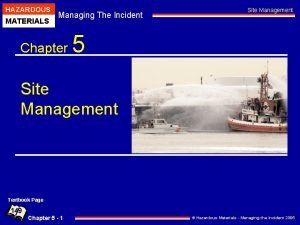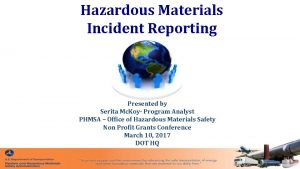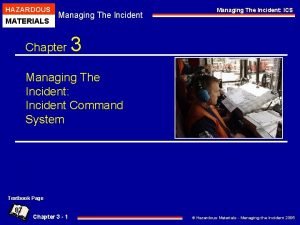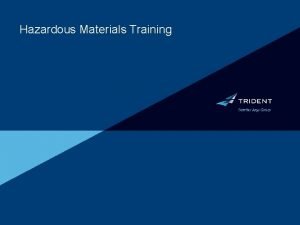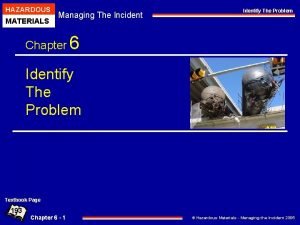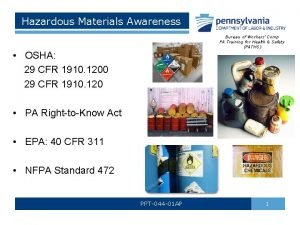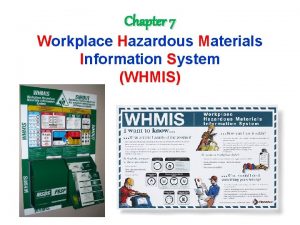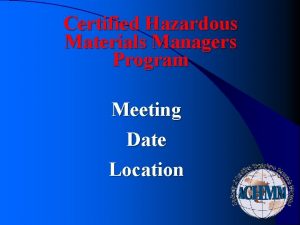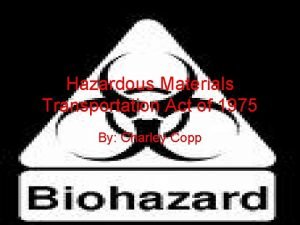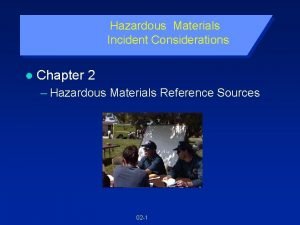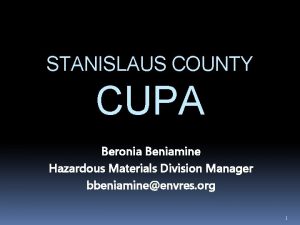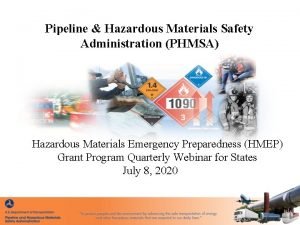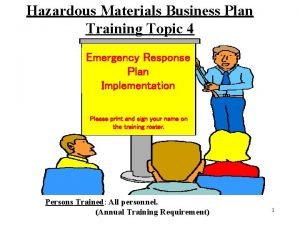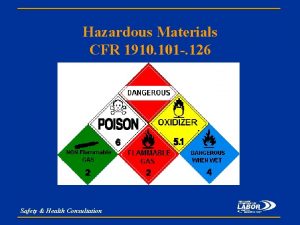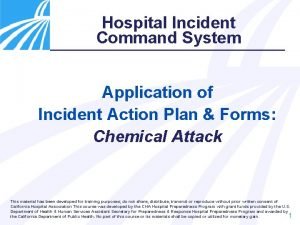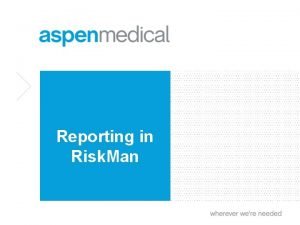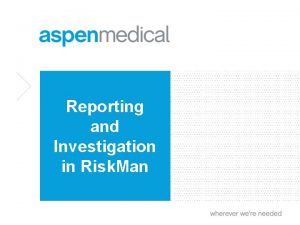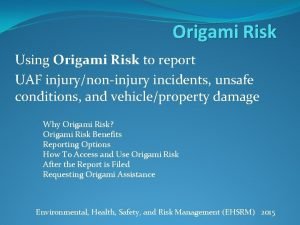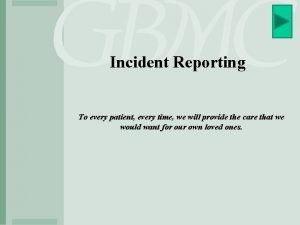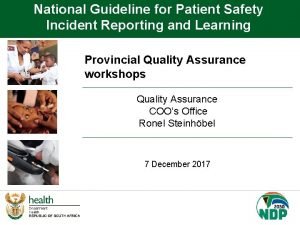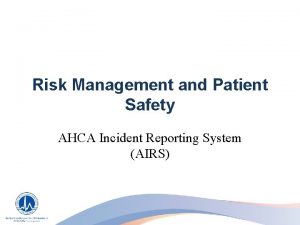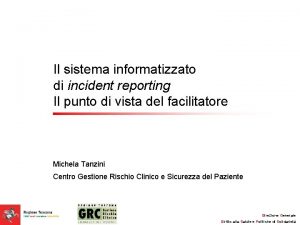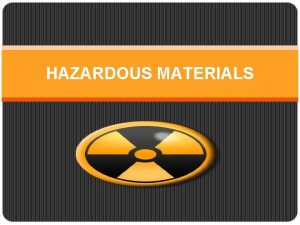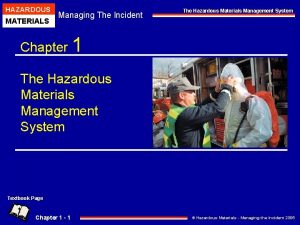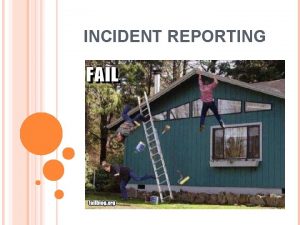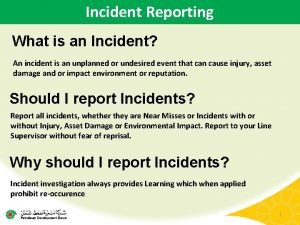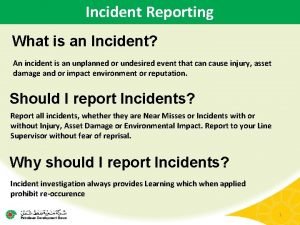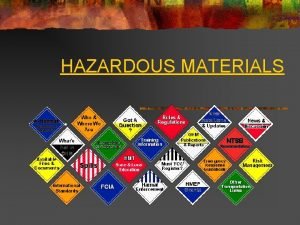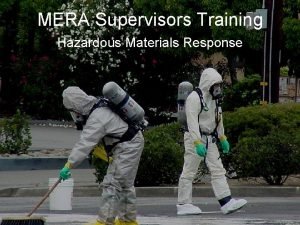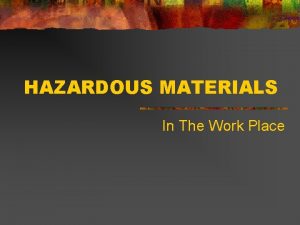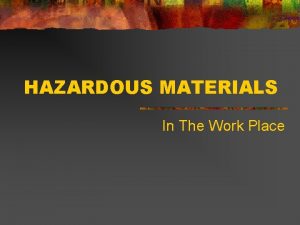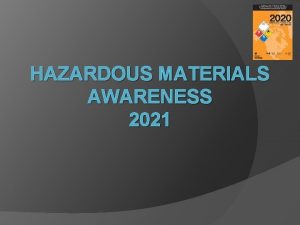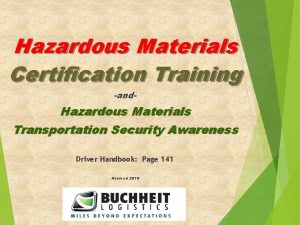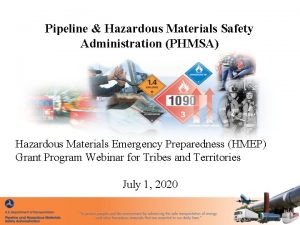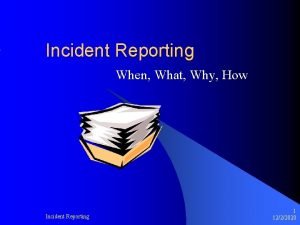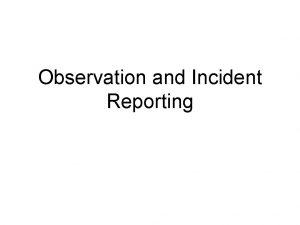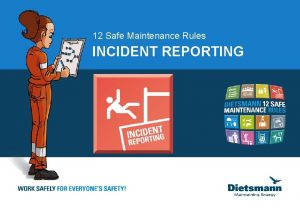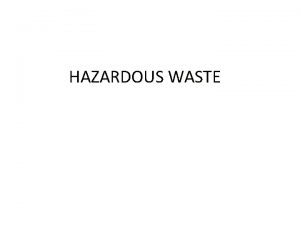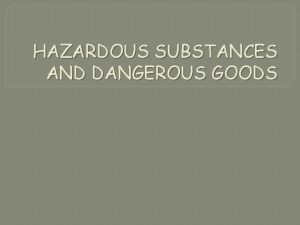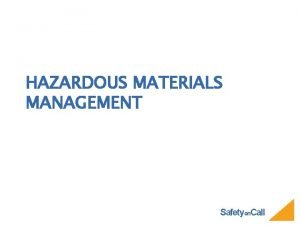Hazardous Materials Incident Reporting PROGRAM MANAGEMENT REVIEW Task
























- Slides: 24

Hazardous Materials Incident Reporting PROGRAM MANAGEMENT REVIEW Task 16 Period of Review (JAN-MARCH) 5/26/2016 Presented by Serita Mc. Koy- Program Analyst PHMSA – Office of Hazardous Materials Safety Non Profit Grants Conference March 10, 2017 DOT HQ

Agenda Overview – PHMSA Vision and Mission DOT 5800. 1 Incident Report Overview Uses of Information Trends & Statistics Questions

PHMSA Mission & Vision PHMSA’s mission is to protect people and the environment by advancing the safe transportation of energy and other hazardous materials that are essential to our daily lives. PHMSA’s vision is to become the most innovative transportation safety organization in the world

OHMS Key Priorities • Invest in Our People • Increase Communication – Internal – External • Position for Innovation • Foster Transparency • Improve Engagement – Employees – Partners – Stakeholders


Incidents “Think before you” ship!”

What is an Incident? An unintentional release of a hazardous material or discharge of hazardous waste; a cargo tank with a capacity of 1, 000 gallons or greater containing any hazardous material that suffers structural damage to the lading retention system; or an undeclared hazardous material.

When is a DOT 5800. 1 Form required? § 49 CFR Parts 171 -180 requires certain types of incidents be reported. § Section 171. 15 requires an immediate telephonic report be filed within 12 hours of certain hazmat incidents. 1. A person is killed 2. Injury requiring admittance to the hospital 3. Evacuation of general public for one hour or more 4. One or more major transportation arteries are closed for one hour or more 5. Operational flight plan is altered 6. Fire, breakage, spillage involving radioactive material 7. Fire, breakage, spillage involving an infectious substance 8. Release of marine pollutant in a quantity exceeding 450 liters for liquid or 400 kilograms for solids

When is a DOT 5800. 1 Form required? • Section 171. 16 requires that a 5800. 1 report be submitted within 30 days of discovery of any of the following: 1. 2. An incident that was reported under 171. 15 An unintentional release of a hazardous material during transportation 3. 4. 5. Release of a hazardous waste Undeclared shipment with no release is discovered A Specification Cargo Tank 1, 000 gallons or greater containing hazardous materials that received structural damage to the lading retention system and did not have a release.

What Data Do We Collect Via the 5800. 1? w Who, What, Where, and When w Characteristics of the release: • Material • Packaging • Hazard Communication • Handling w Compliance and non-compliance w Consequences w Causation

• Identify key hazards, risk factors and issues • • Monitor to ensure compliance, course correction and continuous improvement • Manage the risk through implementation of strategies and communication with stakeholders Assess the risk associated with each factor and develop mitigation strategies

Incident Statistics Number of Incidents by Mode 2015 - 2019 84, 608 92, 651 100, 000 90, 000 80, 000 70, 000 60, 000 2, 444 5, 545 54 50, 000 40, 000 30, 000 20, 000 10, 000 0 FAA-AIR FMCSA-HIGHWAY FRA-RAILWAY USCG-WATER Grand Total




Incident Statistics Incidents by Transportation Phase and Damages $379, 136, 468 2015 - 2019 $400, 000 $350, 000 $300, 000 $250, 000 $200, 000 $150, 000 $27, 248, 745 $15, 359, 429 $100, 000 $41, 288, 100 $50, 000 $0 IN TRANSIT STORAGE LOADING UNLOADING

Incident Statistics Incidents by Results and Mode 2015 - 2019 Water Sewer Environmental Damage No Release Gas Dispersion Explosions Fire Spillage 0% 20% FAA-AIR 40% FMCSA-HIGHWAY 60% FRA-RAILWAY 80% USCG-WATER 100% 120%

Incident Statistics Casualty Classification 2015 - 2019 584 600 500 400 239 300 200 56 10 94 36 35 7 0 100 0 Hospitalized General Public Non-Hospitalized Emergency Responder (Fire, Police, EMT. . . ) Fatalities Transportation Worker (Employee)

If you are not searching for a specific incident, you may enter a date range to view a certain amount of months/years of data Select one or more modes if you want to filter your results to show incidents only for that mode. *Note: To view all modes, leave this field blank. Trends and Statistics Only select State if you are searching for information on one particular state

Trends and Statistics You can export “all fields” or the “most requested fields”.

Incident Report Statistics Available Reports § Yearly Incident Summary Reports § 10 Year Incident Summary Reports • Casualty Classification • All Incidents • Transportation Phase • Accident/Derailment Incidents • Incidents by Results • RAM Incidents • Incidents Cause by Mode • Waste Incidents • Incident by Hazard Class • Serious Incidents (Old definition) • Incidents by Commodity Rank • • Undeclared Incidents by State Serious Incidents (Current definition) • Bulk Containers • Undeclared Incidents • Incidents by State • Bulk Incidents • Serious Incidents Map • Non-Bulk Incidents

Incident Report Statistics

Incident Contact Information § Hazardous Materials Information Center • 800 -647 -4922 § General Inquiries - Email • Phmsa. HAZMATICS@dot. gov

Questions
 Hazardous materials managing the incident
Hazardous materials managing the incident Hazardous materials incident report
Hazardous materials incident report Hazardous materials managing the incident
Hazardous materials managing the incident What is hazardous material
What is hazardous material Hazardous materials table
Hazardous materials table Us military marking system for hazardous materials
Us military marking system for hazardous materials Pa-psfa-hazardous materials awareness
Pa-psfa-hazardous materials awareness Shape and color of whmis 2015 symbols
Shape and color of whmis 2015 symbols Isachmm
Isachmm Hazardous materials transportation act of 1975
Hazardous materials transportation act of 1975 Hazardous materials reference books
Hazardous materials reference books Stanislaus county hazardous waste
Stanislaus county hazardous waste Pipeline and hazardous materials administration
Pipeline and hazardous materials administration Hazardous materials business plan
Hazardous materials business plan Compressed gas association pamphlet p 1 1965
Compressed gas association pamphlet p 1 1965 Incident objectives that drive incident operations
Incident objectives that drive incident operations Near miss examples
Near miss examples 12vac35-105-520
12vac35-105-520 Riskman login
Riskman login Riskman incident reporting
Riskman incident reporting Origami risk login
Origami risk login Quantros incident reporting system
Quantros incident reporting system Patient safety incident definition
Patient safety incident definition Ahca incident report form
Ahca incident report form Scheda incident reporting
Scheda incident reporting
